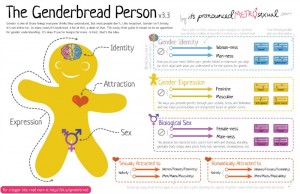Gender identity, the gender spectrum, and transgender issues have been getting a lot of media attention in recent years. Laverne Cox, from Orange is the New Black was featured as the first openly transgender person on the cover of Time Magazine in 2014. The Amazon series, Transparent, which follows Jefferey Tambor’s character coming out to his self absorbed family as transgender, won the Golden Globe for Best Television Series (musical/comedy). And most recently, the gold medal winning Olympian, father, and step-father to the popular Kardashian-Jenner family, Bruce Jenner has also come out as transgender, in that he identifies internally as a woman.
The anticipated Diane Sawyer interview, in which Jenner shares his story, aired April 24th, 2015. If you missed it, here is a link where you can access segments of the ABC interview.
I, along with many others, tuned in with curiosity, skepticism, and hope. I, admittedly, wasn’t expecting to be influenced too much by this interview. I work with transgender & gender nonconforming clients and feel connected to the issues in our culture around gender & sexuality. I’m not saying I’m an expert by any means, but I would consider myself an ally & LGBTQ affirming therapist. I was interested in watching mainly because I felt hopeful that Bruce was going to share about his experience & possibly demystify some of the tabloid rumors about him as well as the trans population in general. In the midst of watching, I found myself experiencing a number of emotional responses. From sadness & tears, to anger & frustration, followed by compassion & motivation.
I was motivated to respond, in this post, to Jenner’s interview & coming out in hopes of clarifying some of the misconceptions around gender. As I began writing, I realized how many facets there are to consider when exploring gender diversity, so this will be the first in a series of post related to understanding gender identity.
The Basics: Gender, Sex, & Attraction
Gender Binary vs. Gender Continuum/Spectrum
Our society has an unspoken need or tendency to categorize and label; black or white, gay or straight, male or female. This is not necessarily a “good” or “bad” thing. It is simply the way most people have come to understand gender. This may seem rigid & incorrect for many (particularly those who do not fit into these categories), but acknowledging that this perspective continues to be where many people approach gender, is important as we move toward change.
“Western culture has come to view gender as a binary concept, with two rigidly fixed options: male or female, both grounded in a person’s physical anatomy (genderspectrum.org).” At birth we are assigned male or female, but this binary concept fails to account for the rich variation that exists. The gender spectrum is a linear model ranging from 100% male to 100% female, with various states of androgyny in between. This model is much more inclusive & encompasses all people rather than just those who fall into the gender binary.
This “Genderbread Person” is a great illustration explaining the gender continuum, as well as sexuality & expression which can aid in better understanding gender identity.

Gender Identity vs. Biological Sex
Biological sex consists of the physical traits we are born with, including genitalia, hormones, body shape, voice, etc. A person’s biological sex does not always correspond to their gender.
Gender identity is a person’s private sense or internal perception of gender, which is separate from physical sex, it is how someone feels inside, whether male, female or somewhere in between or outside these labels.
When our gender identity & assigned sex at birth match up, we are considered gender normative or cisgender.
So, in basic terms, being transgender is when what is assigned at birth doesn’t fit with how we feel internally.
The way we outwardly convey gender, through dress, demeanor, actions, & interests makes up our gender expression. Gender expression is influenced by gender norms, so someone may have been assigned male at birth but internally identify as female and continue to dress & act male in order to fit into societal norms.
Sexual Orientation
Who we are attracted to, emotionally, romantically, sexually, is independent from our gender & gender identity. People who are straight typically have feelings mainly for people of the opposite sex, while those who are gay or lesbian have these feelings for those of the same sex, & those who are bisexual have feelings for both. People who are asexual experience little to no attraction to either sex. Just as someone who is cisgender (or gender normative) may be gay, straight, bisexual, queer etc., the same is true for someone who identifies as transgender. We all have a gender as well as a sexual orientation and one does not infer the other.
As with any group of people, there is a lot of diversity and variation. The transgender umbrella encompasses all of this variation, from gender queer, gender nonconforming, transsexual, bigender, third sex, gender fluid, and more.
There are many terms & definitions and it is okay to make mistakes, especially when you remain open, curious, and non-judgmental. Understanding gender identity and all of the terms all at once can be a lot to take in. I will provide an overview of terms and do’s & don’ts in my next post. In the mean time, acknowledging & reconsidering our culture’s gender binary model & understanding that just as with personalities, race, & culture, there is a wide array of diversity within gender & sexuality for us to embrace, respect, and value.
With April 15th & the stress of tax season behind us (most of us anyway), the topic of money may still be lurking in the shadows. It is common for money to be left in the dark, along with other hot button issues, like religion & sex. Couples and money can often be a recipe for argument and struggle, but it can also be a challenge for us as individuals. The money struggles in relationships are not as much about account balances and spending habits, but more about the meanings attached to money. Those meanings are often connected to difficult feelings of shame, guilt, & inadequacy, making it a very unpopular conversation topic. Despite it’s significance, we often choose not to discuss money, its meaning, and its role in our lives. So how can we encourage discussion around this daunting, yet crucial subject?
By familiarizing ourselves with what money represents to us, we can develop a greater understanding of our patterns & behaviors with money, as well as find compassion for the ways our partner relates to money. Just as we adapt various defense mechanisms in response to challenging life events, we develop associations with money depending on what was seen or experienced growing up. Consider what comes up for you when you reflect on your own beliefs and attitudes around money. Do you feel a certain amount of money can provide you with the status you desire, does it contribute to your feeling of safety or stability? It can help to begin considering how or if money was talked about in your home growing up. Was it a topic that was argued about? Was it one that was never discussed? Was one parent a spender & the other a saver? Did your family have a lot of money or did you struggle to make ends meet? We may adapt by going in the extreme opposite direction of a parent or by even by following in their footsteps. Whatever the case, it is beneficial to first connect to your own experience with money before understanding where your partner is coming from. It will also aid in more clearly expressing your perspective to your partner.
As a couple decide on a time that you will dedicate to talk about your finances. Agree that each of you will do some self-reflecting about your own fears, values, & experiences with money (it can be helpful to write it down). It is important that each person is calm & open, so consider outside stressors when scheduling a time. For instance, the day before a deadline, the week of preparing for a trip, or when guests are visiting from out of town are probably not going to be times when each person can remain calm & avoid distractions. Also decide on the length of the discussion. It is better to have a start & end time you each agree to so that the conversation doesn’t go on and on to where one or both dreads having to revisit the topic in the future.
When talking about any difficult subject it is useful for couples to remain curious, compassionate, and open. You can take turns sharing your childhood messages about money. Ask one another questions or reflect back what you are hearing to let one another know you understand what is being shared. Hopefully this conversation will bring each of you some insight into the other’s relationship with money & you can then begin talking about the concerns you might have about your partner’s money style in relation to your own. Also, acknowledge what you admire or appreciate about your partner’s approach to finances. Positive statements can help couples feel safe enough to continue talking about challenging issues.
Once each of you have shared & heard your money stories you can begin talking about goals for the future. The first goal might simply be to schedule a regular time (weekly/monthly) to talk about finances. Once this accountability is established, each person can create a list of 3-5 short term & long term goals you’d like to work towards as you start making a budget or plan for the future. Begin creating a budget and incorporating the shared goals that show up on both of your lists. This will allow for greater collaboration and motivation as you begin creating financial plans that will impact you as individuals and as partners.
There are, of course, many issues related to couples and money and some are more individualized than others. These tips are meant to help you as an individual and as a partner become more open and less fearful of talking about a topic we often avoid. Once you begin shedding light on the subject, it becomes less scary and more approachable, especially if you can come together as a team and address it together.












